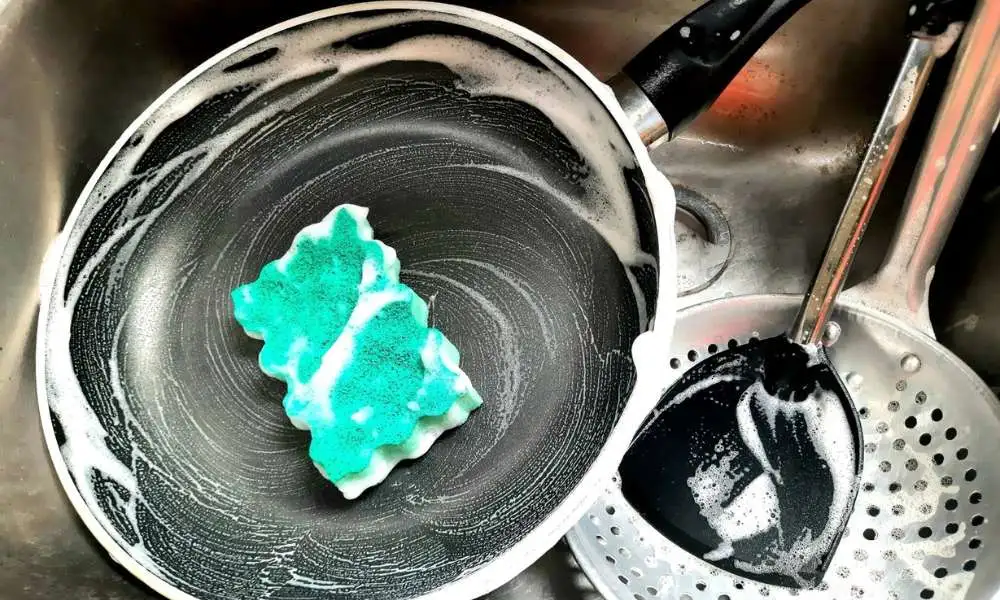Clean your ceramic cookware is as simple as using a mild dishwashing detergent and warm water. Simply fill a sink with enough water to cover the pots and pans, add the detergent, and scrub the cookware clean with a soft cloth. Be sure to rinse off the pots and pans thoroughly before storing them away.
Ceramics is a material that is naturally non-stick, so it doesn’t require any additional oil or butter to prevent food from sticking. This makes it a great choice if you’re looking to reduce your environmental impact or if you have allergies or sensitivities to traditional cooking oils.
How to Avoid Burning Food on Ceramic Cookware?
Cleaning your ceramic cookware is an important part of preventing food from burning on the surface. Here are few tips for cleaning your cookwares:
- Remove any excess food before washing.
- Wash it with a mild dishwashing detergent and warm water. Use a soft sponge to clean the inside and outside of the pot.
- Rinse the pot and dry it with a towel.
- If there are burnt areas, use a stainless steel scrubber or piece scouring pad to gently remove the burnt residue. Be sure to rinse off all residues before using them again.
- Never use harsh chemicals or abrasives when cleaning it, as this could damage the surface finish.
How to Clean A Burnt Ceramic Cookware easily?

If your ceramic cookware is stained, burned, or just looking a little grungy, there are a few easy steps you can take to clean it. First and foremost, don’t try to scrub the dirt or burnt residue with anything abrasive – this will only cause further damage. Instead, use mild dishwashing soap and warm water. Be careful not to get the soap into any of the cracks or crevices on it – these areas are especially prone to corrosion. Rinse everything thoroughly and allow them to dry before using it again.
How Often to Clean Ceramic Cookware
This is a question that can be difficult to answer since everyone has different cooking habits and preferences. However, general guidelines suggest that cookware should clean once a month if used regularly. It is important to remember that ceramic cookwares are delicate and should not scour or roughened in any way. Instead, gentle soap and water should use with a soft sponge or cloth.
Dos Of Cleaning Ceramic Cookware
It is not as difficult as people may believe. There are a few dos and don’ts that should follow to keep your cookwares looking and performing its best.
- Don’t use harsh detergents or abrasives. These cleaners will damage the surface.
- Always use warm, soapy water and a soft cloth when cleaning your cookwares. Use a mild dishwashing soap if necessary. Avoid using bleach or other harsh chemicals, which could damage the finish.
- Never heat your cookwares in the oven or on the stovetop with any non-stick materials like aluminum foil wrapped around it; this can create an intense fire hazard. Instead, place metal utensils directly into the cooking pot or pan.
What You’ll Need
- Hot Water
- Dish Soap
- Salt
- Dishtowel
- Sink Or Large Dishpan
- Baking Soda
- White Vinegar
- Hydrogen Peroxide
- Sponge Or Soft Dishcloth
9 Best Ways To Clean Ceramic Cookware
This can be a daunting task, but with the right tools and techniques, it’s easy to keep your cookwares looking and working like new. Here are the nine best ways to clean:
1. Hot Water

Cleaning ceramic cookware can seem like a daunting task, but with the right tools and techniques, it’s easy to keep your pots and pans looking new.
Use a non-abrasive cleaner. Many commercial cleaners specifically designed for ceramics are harsh and will damage the surface. Try a gentle soap like dishwashing liquid or natural mineral oil soap. Be sure to rinse well to remove all the cleaners.
Use hot water and a cloth. Hot water is effective at breaking down grease and grime, while the cloth helps absorb excess water. Soak the cloth in hot water first, then wring it out so that it’s damp but not dripping wet. Rub the dirty area of the pot with the wet cloth, then rinse off with cold water. Repeat as necessary.
2. Dish Soap
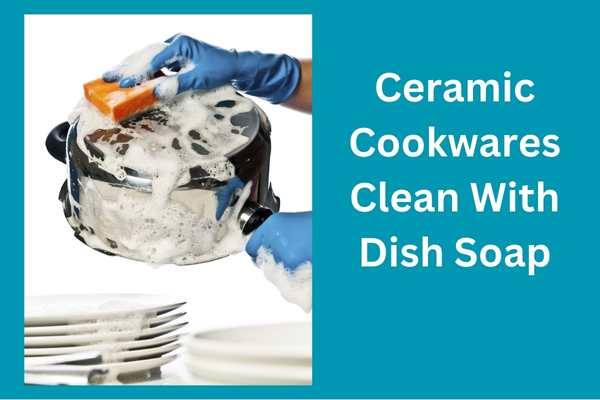
What could be more satisfying than coming home to a clean kitchen? Unfortunately, many of us don’t have the time or inclination to scrub our cookwares by hand. Fortunately, there are products on the market specifically designed to clean cookware without damaging it.
One such product is Dish Soap Ceramic Cleaner from KitchenAid. This soap-and-water mixture can use on all types of ceramic cookwares including nonstick pans and stockpots. The cleaner is safe to use on delicate surfaces and leaves your cookwares looking like new.
If you’re looking for a quick and easy way to keep your cookware looking its best, give Dish Soap Ceramic Cleaner a try.
3. Salt

Salt is an essential ingredient for cleaning cookware. Without it, the pans will not be able to take on the heat and will become dirty very quickly. Additionally, using too much salt can cause burns. A good rule of thumb is to use just enough salt to make the pan sweat, but not so much that it starts burning.
4. Dishtowel

Do you have a dish towel lying around that you don’t use? Maybe it’s been in your drawer for years, or maybe it just doesn’t fit the task at hand. If so, there’s no need to feel guilty about wasting one—especially if you’re using a dirty dish towel to clean your cookware.
Dish towels are specially designed to be used as cleaning cloths and are made of 100% cotton. They can help to clean the surface of ceramic cookwares quickly and easily, without scratching the surface. Additionally, they’re absorbent enough that they can be used to dry dishes after washing them.
5. Sink Or Large Dishpan
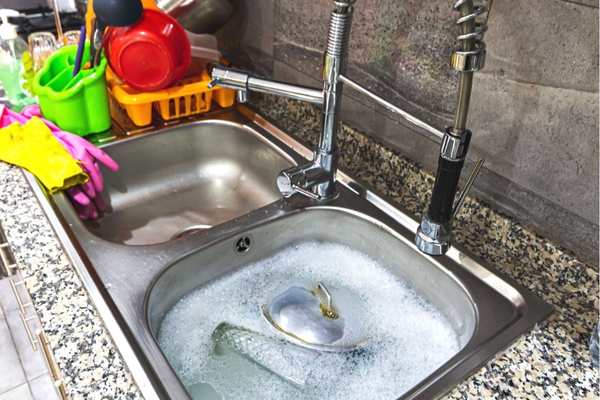
For those of you who have cookware that is not dishwasher safe, there are a few options for cleaning it. One option is to use a sink. Place it in the sink and fill it with hot water. Place a cloth or paper towel over the top of it and let it soak for 10 minutes. Drain the water and rinse it with cold water.
Repeat this process if necessary. Another option is to use a large dishpan. Fill the dishpan with water and place them in it. Bring the water to a boil and let it simmer for 10 minutes. Remove from the pan and let it dry out for 24 hours before using it again.
6. Baking Soda
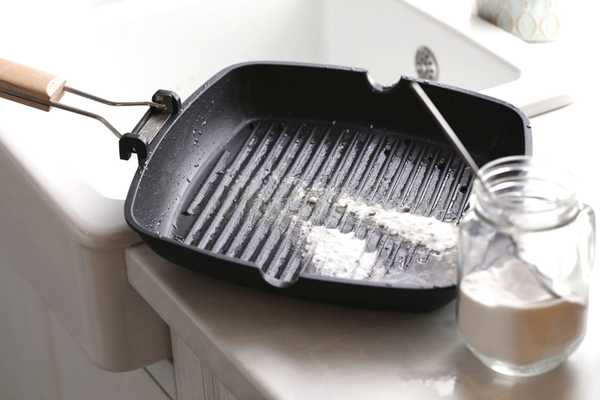
Baking soda can be used to clean virtually any type of cookwares. Simply mix 1/2 cup of baking soda with enough water to make a paste, and apply the paste using a cloth or sponge. Let sit for 30 minutes, and then rinse it off with warm water. Baking soda is effective at removing grease, food particles, and other cooking residues from cookwares.
7. White Vinegar
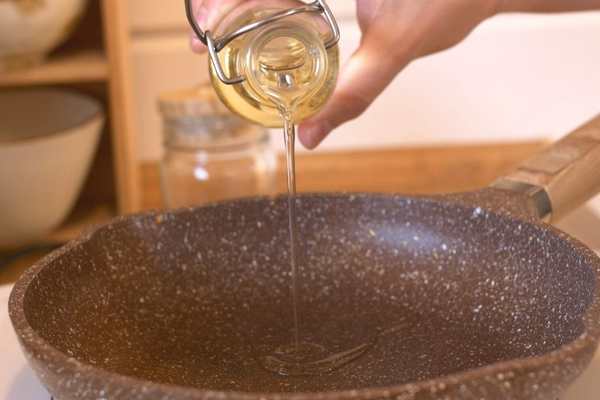
White vinegar can be used as a substitute for regular cleaning products on ceramic cookwares. It is effective and safe to use on most types of cookwares. Simply fill a pot or pan with white vinegar and place it on the stovetop. When the vinegar begins to boil, turn the heat down low and let it simmer for a few minutes. Then take the pot off of the heat and allow it to cool before using it.
8. Hydrogen Peroxide

Hydrogen peroxide is a common household cleaner and has been used for centuries to clean delicate surfaces. It is also effective at killing bacteria and viruses. Hydrogen peroxide can be used with any type of cookwares, including ceramic, aluminum, and steel.
The key to using hydrogen peroxide safely is to read the manufacturer’s instructions carefully. If you are using it on metal cookware, avoid contact with acidic foods or beverages. Use a non-scratch pad to clean the surface before rinsing with water.
9. Sponge Or Soft Dishcloth

Cleaning ceramic cookware is a chore, but it can be made much easier with a sponge or soft dishcloth. Sponges are effective at cleaning the surface, while soft dishcloths work well at getting into the cracks and crevices. Just be sure to rinse the cookwares thoroughly after using either type of cleaning agent to avoid staining or leaving behind any residue.
Seasoning Ceramic Cookware
Seasoning ceramic cookware can make your kitchen tasks much easier. By applying a little oil, salt, pepper, or herbs to your cookwares before each use, you’ll be able to quickly and easily prepare meals without having to fuss with dirty pots and pans.
Here are 6 simple methods for seasoning your ceramic cookware:
1. Clean Your Ceramic Cookware With Baking Soda And Vinegar
Baking soda and vinegar are two common household cleaning agents that can be used to clean cookware. Both substances have a high pH level, which makes them effective at breaking down grease and food residue. Baking soda also has a slightly abrasive effect, which helps to remove stubborn stains. Vinegar is also effective at removing oil and grease, but it may discolor some cookwares. Before using either substance to clean ceramic cookwares, be sure to test a small area first to make sure it will not become damaged.
2. Clean Your Ceramic Cookware With Dryer Sheets
Looking for a way to add a little flavor to your cooking? Try seasoning your cookware with ceramic dryer sheets. These sheets can be found at most hardware stores and are made of clay, which helps to absorb flavors from food. Simply place the sheet on top of your cookwares and microwave for about 30 seconds. The clay will start to heat up and will release its fragrance into the food. This is a great way to add a little zing to your meals without having to use any additional spices or ingredients.
3. Wash Your Ceramic Cookwares With Hydrogen Peroxide
Hydrogen peroxide is a common household additive that can be used as a natural seasoning for ceramic cookwares. This chemical has a variety of uses, including as a bleaching agent, disinfectant, And anti-foaming agent. Hydrogen peroxide is safe to use in cookwares, but should not be used if it is lacquered or painted.
4. Spray Your Ceramic Cookwares With An Enzyme Solution
Seasoning your cookware can make all the difference when cooking. A good way to do this is by using an enzyme solution. Enzyme solutions can be found in most grocery stores, and they are a great way to add extra flavor to your meals. By using an enzyme solution, you won’t have to worry about seasonings being too overpowering, and you’ll be able to enjoy the natural flavors of the foods that you’re cooking.
5. Let Your Ceramic Cookwares Simmer On A Burner
When it comes to cooking, nothing beats the taste and convenience of a good stovetop burner. So what are the best burners for your kitchen? Seasoning ceramic cookware is a great option because it not only heats quickly but also retains heat well so you can cook meals evenly and safely. In addition, these pots and pans resist heat distortion so they work great with all types of food. Whether you’re in the mood for some easy skillet meals or something more complex like braised beef or chicken, a good seasoning ceramic cookwares set is a must-have in your kitchen!
6. Use A Pinch Of Salt to Scrub Your Ceramic Cookwares
A pinch of salt to scrub your ceramic cookware is a must. Not only will it keep looking like new, but it will also help to remove any built-up residue that may be preventing your pots and pans from performing their best.
Add a pinch of salt to the scrubbing pad and start cleaning the surface of your ceramic cookwares. Be sure to work around the edges and underneath the pots and pans, as these areas are often overlooked. Use circular motions with the scrubbing pad, being careful not to scratch the surface. Continue until all surfaces have been cleaned. Wipe down the pot or pan with a dry cloth to finish.
Do When Cleaning A Ceramic Cookware
Cleaning ceramic cookware can be a daunting task, but with a few simple steps, It can be done easily. Before cleaning, inspect the piece for any cracks or chips. If there are any defects, do not clean the cookware until they have been fixed. Here are the steps to cleaning ceramic cookware:
1. Allow The Ceramic Cookware to Cool
If your ceramic cookware is not copper or nonstick, allow it to cool completely before cleaning. Nonstick surfaces may be cleaned with mild dishwashing soap and warm water. Copper cookwares should be hand-washed with a good quality all-purpose cleaner and lukewarm water. Never use abrasive cleaners or boiling water on copper cookwares. After washing, dry the pot with a soft cloth. If the item has a nonstick coating, simply apply a little cooking oil to the surface and heat over medium heat until the oil is melted.
2. Fill A Sink With Water And Dish Soap
When it comes to cleaning cookware, a good soak in warm water and dish soap is always the best approach. However, some cookwares are made of materials that are difficult or impossible to clean using just water and soap. That’s where gentle cleaners like Barkeepers Friend come in handy. Just fill a sink with enough water to cover the bottom of your pot or pan, turn on the faucet, and wait until the cleaner has diluted itself before adding soap. Be sure to rinse all dishes and pots well before putting them away.
3. Clean With A Sponge
Many people are hesitant to clean their ceramic cookware with a sponge because they fear it will damage the cookwares. However, using a sponge is actually the best way to clean ceramic cookware.
First, dry off the surface of the cookware with a towel. Then, use a mild dish soap on your sponge and scrub the surface until it is completely clean. Be sure not to use too much force; you just want to roughen up the surface so that food doesn’t stick to it. Finally, rinse off the soap and towel combination and dry the surface again.
4. Rinse and Dry
Cleaning ceramic cookware is not as difficult as you might think. In fact, there are a few simple steps that will help keep your cookware looking and performing its best. First and foremost, always dry your cookwares after each use by using a towel or oven mitt to absorb any water. Next, use a mild dishwashing detergent on a sponge to clean the surface of the cookware. Make sure to rinse off the detergent completely before drying. Finally, use a clean cloth or paper towel to polish the surface of your cookwares if needed.
5. Remove Hardened Food With Baking Soda
Cleaning your ceramic cookware is a necessary step to keeping it in good condition. Baking soda is a great way to remove hard water and food residues from your cookware. Follow these simple steps: Preheat your oven to 350 degrees F (175 degrees C). Wet your hands and scrub them with baking soda. Be sure to get all sides of the pot or pan. Let them dry for at least 30 minutes before using them. Avoid using abrasive cleaners on your ceramic cookware; they will damage the finish. Keep your ceramic cookwares seasoned by using oil or butter once a month to prevent sticking and build-up.
6. Remove Discoloration With Hydrogen Peroxide
If your ceramic cookware starts to develop a yellow or brown discoloration, you can remove the discoloration with hydrogen peroxide. Hydrogen peroxide is a common household cleaner that can be used to clean many surfaces including glass and ceramic. To clean your cookware, fill a small bowl with hydrogen peroxide and place it in the bowl. Swish the pot around for a few minutes to get rid of any dirt or oils that may have accumulated on the surface. Wipe down the pot with a clean towel to finish the job.
What Not to Do When Cleaning A Ceramic Cookware
1. Don’t use Abrasive Sponges

Avoid using abrasive sponges. This type of sponge is designed to remove dirt and other contaminants from surfaces. However, the rough surface of this sponge can damage the cookware’s finish. Additionally, abrasive sponges are often ineffective at removing food residue. Instead, try a soft-bristled brush or a nylon pad designed for cleaning ceramics.
2. Never Scrape Off Food With Metal Utensils

When it comes to cleaning cookwares, there are a few things you should never do: Never scrape off food with metal utensils. Doing so can damage the pan and cause metallic flavors in your food. Instead, use a rubber or plastic scraper to get rid of any residue. And be sure to dry the pan thoroughly before using it again.
3. Don’t Use Harsh Detergents
Harsh detergents can damage the surface of your cookware, leaving it looking dull and scratched. Not only will this affect the appearance of your cookwares, but also the finish – which could lead to it deteriorating over time. Instead, use a gentle dishwashing soap that is specifically designed for ceramics. Make sure to rinse off all the soap residue with water before putting your cookware in the dishwasher – this will help prevent any build-up from happening in the future.
4. Avoid Drastic Temperature Changes

When cleaning pieces of ceramic cookwares, it’s important to avoid drastic temperature changes. This means avoiding using hot water or dish soap on the pot itself, and also avoiding putting the pot in the oven or microwave. Instead, use a mild detergent and warm water, and avoid scrubbing the pot with a hard brush.
5. Don’t Soak Your Cookware
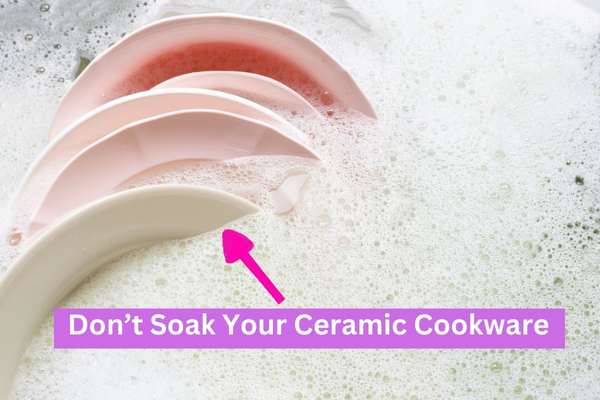
Cleaning ceramic cookware can be a chore, but there are some basic guidelines you should follow to avoid damaging your cookware. Don’t soak this in water or use harsh chemicals; instead, use a mild detergent and a soft cloth. Never put it in the dishwasher; it will damage the finish. Finally, always dry thoroughly before storage.
Discover the best way to clean your Magnalite cookware for perfect results every time. Learn the tips and tricks for making your cookware look like new!
The Final Thought
In conclusion, Clean ceramic cookware is a simple task that can be done with soap and water. Be sure to avoid using abrasives or scouring pads, as these could damage the surface of the cookwares. Additionally, keep in mind that ceramic cookwares are not stainless steel, so it may require more frequent cleaning than traditional cookware.
